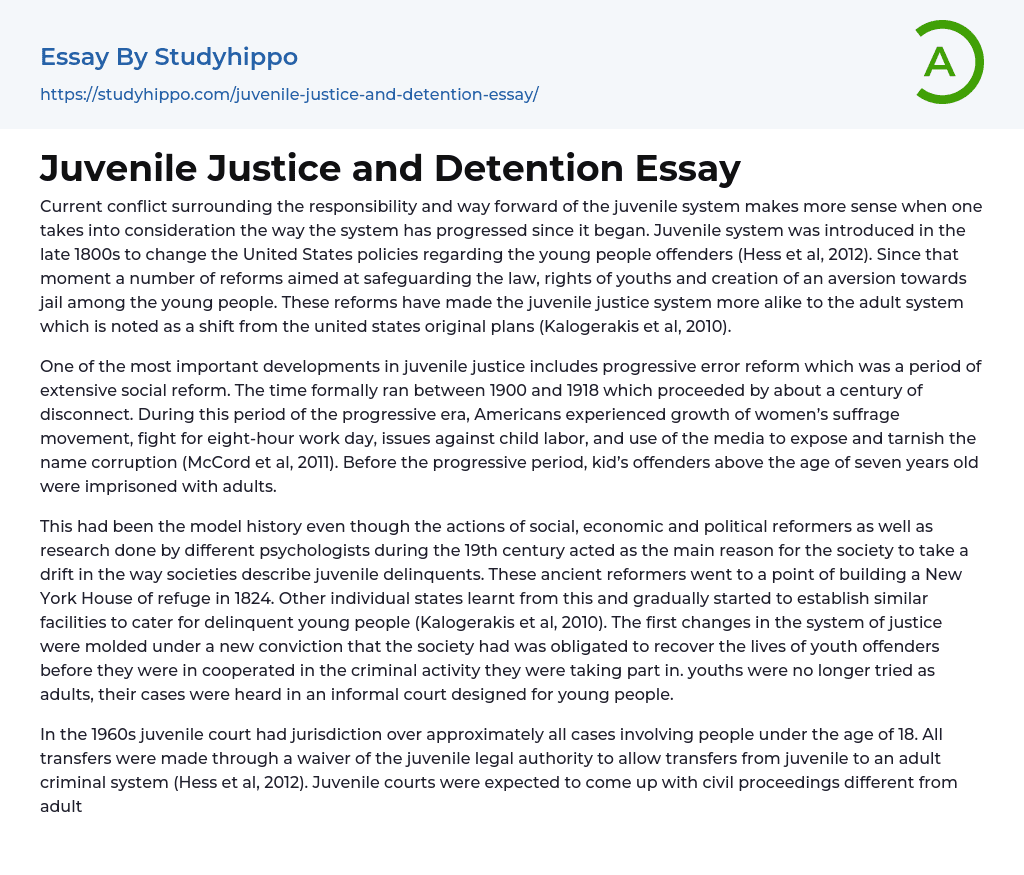When considering the way the juvenile system has progressed since it began, the current conflict surrounding its responsibility and way forward becomes more understandable.
The juvenile system was introduced in the late 1800s with the goal of changing United States policies towards young offenders (Hess et al, 2012). Since its inception, several reforms have been implemented to safeguard the rights and laws pertaining to young individuals and discourage their incarceration. These reforms have led to a more adult-like juvenile justice system, straying from the original intentions of the United States (Kalogerakis et al, 2010). A significant advancement in juvenile justice is the progressive error reform, which occurred between 1900 and 1918 following a century of disconnection.
During the progressive era, reformers focused on enhancing society through various means. These included supporting women's suffrage, advocating for an
...eight-hour work day, opposing child labor, and utilizing media to expose corruption (McCord et al, 2011). In the 19th century, children above seven years old who committed crimes were frequently incarcerated with adults. Despite psychologists' research and early reformers' efforts, this was the prevailing societal approach. Nevertheless, progress occurred with the founding of a New York House of Refuge in 1824.
Similar to other states, various facilities were gradually established to accommodate delinquent young individuals (Kalogerakis et al, 2010). The initial changes in the justice system were driven by a new belief that society had a responsibility to rehabilitate young offenders before they became further involved in criminal activities. Rather than facing trial as adults, juveniles had their cases heard in a specialized court for young people. By the 1960s, almost all cases involving individuals under 18 fell under the jurisdiction o
the juvenile court. Any transfers to the adult criminal system required authorization from the juvenile legal system (Hess et al, 2012).
The purpose of juvenile courts was to establish separate civil proceedings for young individuals, distinct from adult criminal trials. However, these civil processes failed to adequately protect the rights of youth who faced potential loss of freedom. These rights are guaranteed by the due process provisions in the 5th and 14th amendments (McCord et al, 2011). In a subsequent ruling in 1967, the Supreme Court emphasized the importance of respecting juveniles' due process rights throughout their court proceedings. In response to a rise in crime in 1994, legislation known as "get tough on crime" was introduced which aimed to address concerns about escalating juvenile crime rates in the future. As part of this legislation, an amendment was made to the Juvenile and Delinquency Prevention Act granting states the power to try juveniles as adults for weapon violations and certain violent crimes (Kalogerakis et al, 2010).
During a specific time period, the duration of imprisonment was determined by establishing maximum and minimum detention standards in certain locations. These disputes led to changes in the juvenile justice system, aligning it with the adult justice system. Consequently, prioritizing public safety over rehabilitation became prominent in the crusade against crime during the 1990s (Hess et al, 2012).
References
- Kalogerakis, M. G., & American Psychiatric Association. (2010). Handbook of psychiatric practice in the juvenile court: The Workgroup on Psychiatric Practice in the Juvenile Court of the American Psychiatric Association. Washington, DC: American Psychiatric Association.
- Hess, K.
The cited text includes a book titled "Juvenile Justice" by M. and Wright, J. P. in 2012, along with
another book titled "McCord, J., Widom, C. S., Crowell, N. A., & National Research Council (U.S.)".
The National Academy Press in Washington, DC published the book "Juvenile Crime, Juvenile Justice" in 2011.
- Animal Cruelty essays
- Charles Manson essays
- Crime Prevention essays
- Crime scene essays
- Criminal Justice essays
- Criminology essays
- Cyber Crime essays
- Damages essays
- Detention essays
- Distracted Driving essays
- Drug Trafficking essays
- Drunk Driving essays
- Forensic Science essays
- Gang essays
- Hate Crime essays
- Homicide essays
- Identity Theft essays
- Juvenile Crime essays
- Juvenile Delinquency essays
- Juvenile Justice System essays
- Law Enforcement essays
- Murder essays
- Organized Crime essays
- Penology essays
- Piracy essays
- Prison essays
- Property Crime essays
- Prostitution essays
- Punishment essays
- Punishments essays
- Rape essays
- Robbery essays
- Serial Killer essays
- Sexual Assault essays
- Sexual Assault on College Campuses essays
- Sexual Harassment essays
- Sexual Offence essays
- Stealing essays
- Surveillance essays
- Ted Bundy essays
- Victim essays
- Violent crime essays
- White Collar Crime essays




